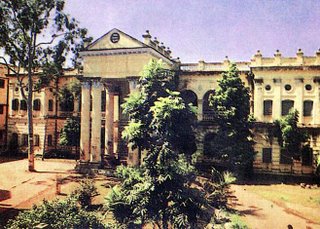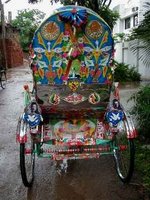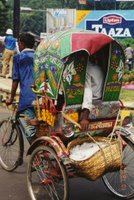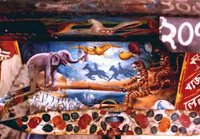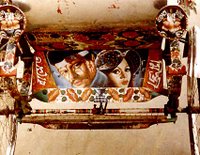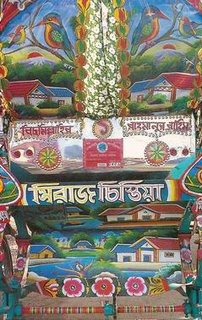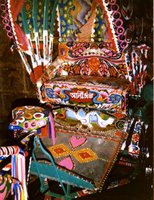
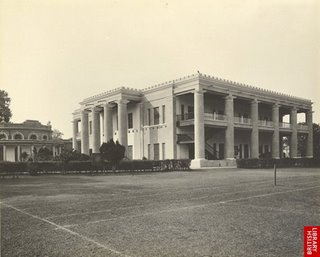
Dhaka College building, later State Bank building, near Bahadur Shah Park
Dhaka College: Started at the premises of an English Seminary school at Dhaka (Dhaka Collegiate School) in 1841 in its extended first floor. The Bishop of Calcutta laid the foundation stone in 1841 when the school was raised to the status of a college. A new building was completed in 1846. In 1842, there were 344 students - Muslims, Hindus, Armenians and Portuguese. In 1848 the number of students reduced to 289 of which 19 were Muslims.
In 1908, it was shifted to the newly built Curzon Hall leaving the old building to the Collegiate School, which later went to house the State Bank. On the establishment of Dhaka University, the college was shifted from Curzon Hall to the present High Court Building. During the Second World War, it was shifted to an old structure in Siddique Bazar.
At present, it has its own premises north of Dhaka New Market. This college is noted as the premier college of Dhaka, and can boast of having had many eminent educationists as its principals, amongst whom were Dr. T. Wise, W. Brennad, W. Booth, F. C. Turner, A. J. Archibald, and Dr. P. K. Roy. The college was affiliated to the University of Calcutta in 1858. Early graduates of Dhaka College included Bazlur Rahim (later Khan Bahadur), Abdul Aziz (Inspector of Schools, Chittagong Division), Zahedur Rahman Zahid (Judge of High Court and father of the late Huseyn Shaheed Suhrawardy), Anisuzzaman Khan (later Additional Chief Presidency Magistrate in Calcutta), Naziruddin Ahmed (later Deputy Magistrate and the first Registrar of Dhaka University) and many others eminent personalities.
Jagannath college, now UniversityJagannath College: founded as Dhaka Brahma School in 1858 by Dinanath Sen, Prabhaticharan Roy, Anathbandhu Mallik and Brajasundar Kaitra. Kishorilal Chowdhury, the Zamindar of Baliadi, took over the school in 1872 and renamed it as Jagannath School after his father. In 1884, it was raised to a second grade college. Law was one of the first courses introduced in the college.
The college started with only 48 students and in five years, the roll raised to 396. In 1910, Jagannath College became known as the best-equipped private college in Dhaka. It goes to the credit of Jagannath College, along with Dhaka College, that the University of Dhaka started in 1921 mainly with students graduated from these two colleges.
Jagannath College opened Honours and Masters programmes in 1975. That year the government took over the college and upgraded it into a postgraduate college. It has about 35,000 students now, of whom about 17% were female. The number of teachers in the college was 350, of whom around 75% of the teachers were female.The college has been upgraded to full-fledged university from September 2005.
The college started with only 48 students and in five years, the roll raised to 396. In 1910, Jagannath College became known as the best-equipped private college in Dhaka. It goes to the credit of Jagannath College, along with Dhaka College, that the University of Dhaka started in 1921 mainly with students graduated from these two colleges.
Jagannath College opened Honours and Masters programmes in 1975. That year the government took over the college and upgraded it into a postgraduate college. It has about 35,000 students now, of whom about 17% were female. The number of teachers in the college was 350, of whom around 75% of the teachers were female.The college has been upgraded to full-fledged university from September 2005.


Notre Dame college, Motijheel
Notre Dame College: Established by the Holy Cross Fathers in 1949 at Lakshmibazar, Dhaka, as the first Catholic college and was named St Gregory College. It was shifted to a new location in 1950 and from there, to its present site at Motijheel in 1954, when it was renamed Notre Dame College. The institution, run by Roman Catholics, open to all students, demonstrated excellent results since the 1950s. The college began with classes in arts and commerce subjects. By 1955, it had Bachelor of Arts courses, and in 1960, it started bachelor of science courses.
It got affiliation with the University of Dhaka in 1955 and in 1959, was declared the best college in East Pakistan in recognition of the high percentage of successful candidates in various university examinations. Meanwhile, the college also earned reputation for its performance in sports and debates and publication of high quality textbooks by its teaching staff.

